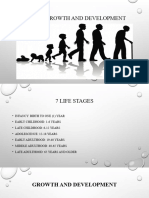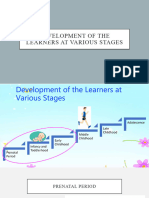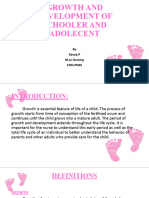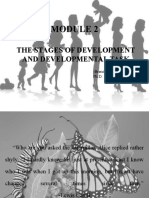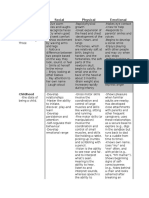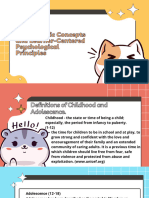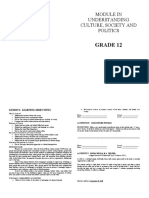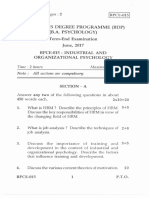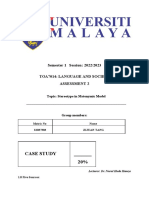GROWTH AND
DEVELOPMENT
�LIFE STAGES
Infancy – birth to 1 year
Early Childhood – 1 to 6 years
Late Childhood – 6 to 12 years
Adolescence – 12 to 20 years
Early Adulthood – 20 to 40 years
Middle Adulthood – 40 to 65 years
Late Adulthood – 65 and up
�Infancy
birth to 1 year
�INFANCY – PHYSICAL
GROWTH
▪The most dramatic and rapid changes in growth and development
occur during the first year of life
▪By the end of the first year of life, a baby’s weight usually triples, and
its height increases by about 10 inches
▪The baby is born with certain reflexes, including the startle reflex, the
rooting reflex, the sucking reflex, and the grasp reflex
▪Muscle coordination develops in this stage – by 12 months. Infants
frequently can walk without assistance, grasp objects with thumb and
fingers, and throw small objects
▪Most infants have 10-12 teeth by the end of this stage
▪Food, cleanliness, and rest are essential for physical growth
�INFANCY – MENTAL
DEVELOPMENT
▪As their needs are met, infants become more aware of their
surroundings and begin to recognize individuals associated with their
care
▪By 6 months, infants understand some words and can make basic
sounds; by 12 months, they understand many words and may use
single words in their vocabularies
▪Stimulation is essential for mental development
�INFANCY – EMOTIONAL
DEVELOPMENT
▪By 4-6 months, distress, delight, anger, disgust, and fear can often be
seen
▪By 12 months, elation and affection for adults is evident
▪Events that occur during the first year of life when these emotions are
first exhibited can have a strong influence on an individual’s emotional
behavior during adulthood
▪Love and security are essential in this stage for both emotional and
social development
�INFANCY –SOCIAL
DEVELOPMENT
▪4 months – infants recognize their caregivers, smile readily, and stare
intently at others
▪6 months – infants watch the activities of others, show signs of
possessiveness, socialize freely with familiar people, and imitate
gestures, facial expressions, and vocal sounds
�Early Childhood
1 to 6 years
�EARLY CHILDHOOD –
PHYSICAL DEVELOPMENT
By age 6, the average weight of a child is 45 pounds and the
average height is 46 inches
The legs and lower body tend to grow more rapidly during this stage
than the head, arms, and chest
During these years, the child’s fine motor skills increase
By the age of 2 or 3, most children learn bladder and bowel control
�EARLY CHILDHOOD –
MENTAL DEVELOPMENT
▪By the age of 6, verbal growth progresses to the use of about 2,500
words
▪2-year-olds can remember details and begin to understand concepts
▪4-year-olds ask frequent questions
▪6-year-olds are very verbal and want to learn how to read and write
�EARLY CHILDHOOD –
EMOTIONAL
DEVELOPMENT
▪At age 1-2, children begin to develop self-awareness
▪They begin to feel impatience and frustration as they try to do things
beyond their abilities; anger, or temper tantrums, occur when they
cannot perform what they desire
▪Children at this age also learn routine, and become stubborn when
changes are presented
▪They also learn the concept of right and wrong
�EARLY CHILDHOOD –
SOCIAL DEVELOPMENT
▪During this stage, children begin to enjoy the company of other people,
but are still possessive
▪Playing alongside other children is more common than playing with other
children
▪Gradually, they learn to put themselves aside and take more of an
interest in other people by becoming more agreeable and social
�Late Childhood
6 to 12 years
�LATE CHILDHOOD –
PHYSICAL DEVELOPMENT
▪Weight gain averages 5-7 pounds per year and height usually increases
2-3 inches per year
▪Muscle coordination is well developed, and children can engage in physical
activities that require complex motor sensory coordination
▪The eyes are also well developed, and visual acuity is at its best
▪Most of the primary teeth are lost during this stage, and permanent teeth
come in
�LATE CHILDHOOD –
MENTAL DEVELOPMENT
▪Much of the child’s life centers around school; speech skills develop
more completely, and reading and writing skills are learned
▪Children’s memory becomes more complex
▪They begin to understand more abstract concepts, such as loyalty,
honesty, values, and morals, which allows them to become more adept
at making judgments and decisions
�LATE CHILDHOOD –
EMOTIONAL
DEVELOPMENT
▪The child continues to achieve a greater independence and a more
distinct personality
▪At the beginning of this stage, children are often frightened and
uncertain as they begin school; gradually, those fears are replaced by
the ability to cope
�LATE CHILDHOOD –
SOCIAL DEVELOPMENT
▪7-year-olds like activities they can do by themselves as opposed to
group activities, but they want the approval of others
▪Children from ages 8 to 10 tend to be more group oriented, creating
friend groups with kids of their own gender
▪Children are more ready to accept the opinions of others and they
conform to rules and standards of behavior followed by the group
▪Toward the end of this stage, children begin to make friends more
easily, and develop awareness of the opposite gender
�Adolescence
12 to 20 years
�ADOLESCENCE – PHYSICAL
DEVELOPMENT
▪During this stage, adolescents go through “growth spurts,” which can
cause rapid increases of height and weight.
▪Because muscle coordination does not advance as quickly, the lag can
lead to awkwardness or clumsiness in motor coordination
▪The most obvious physical changes in adolescents relate to the
development of the sexual organs and secondary sexual
characteristics
▪Secretion of sex hormones leads to the onset of menstruation in girls
and the production of sperm and semen in boys
�ADOLESCENCE – MENTAL
DEVELOPMENT
▪Primarily involves an increase in knowledge and a sharpening of skills
▪Adolescents learn to make decisions and accept responsibility for their
actions
�ADOLESCENCE –
EMOTIONAL
DEVELOPMENT
▪Development in this stage is often stormy and in conflict; as they try to
establish their identities and independence, they are often uncertain
and feel inadequate and insecure
▪Adolescents worry about their appearances, abilities, and
relationships with others
▪They frequently respond more and more to peer group influences,
which at times, leads to changes in attitude and behavior, as well as
conflict with values they previously established
▪Towards the end of adolescence, self-identity has been established,
and teenagers feel more comfortable with who they are and turn
attention toward what they may become
�ADOLESCENCE – SOCIAL
DEVELOPMENT
▪Teenagers typically spend less time with family and more time with
peer groups
▪As they begin to develop self-identity and independence, they seek
security in groups of people their own age who have similar problems
and conflicts
▪Towards the end of this stage, adolescents develop a more mature
attitude and begin to develop patterns of behavior that they
associate with adult behavior or status
�Early Adulthood
20 to 40 years
�EARLY ADULTHOOD –
PHYSICAL DEVELOPMENT
▪Physical development is basically complete
▪This is the prime childbearing time and usually produces the healthiest
babies
▪Both male and female sexual development is at its peak
�EARLY ADULTHOOD –
MENTAL DEVELOPMENT
▪Many young adults pursue additional education to establish and
progress in their chosen careers; frequently, formal education
continues for many years
▪Young adults deal with independence, making career choices,
establishing a lifestyle, selecting a marital partner, and starting a
family
�EARLY ADULTHOOD –
EMOTIONAL
DEVELOPMENT
▪Development in this stage usually involves preserving the stability
established during previous stages
▪Young adults are subjected to many emotional stresses related to
career, marriage, family, etc.
▪They find satisfaction in their achievements, take responsibility for their
actions, and learn to accept criticism and profit from mistakes
�EARLY ADULTHOOD –
SOCIAL DEVELOPMENT
▪Social development frequently involves moving away from the peer
group, and young adults instead associate with others who have
similar ambitions and interests, regardless of age
▪Young adults often become involved with a mate and form a family
▪In today’s society, young adults do not necessarily adopt traditional
sex roles, and frequently adopt nontraditional roles.
▪ Ex: Males fill positions as nurses and secretaries, where females enter administrative
or construction positions
�Middle Adulthood
40 to 65 years
�MIDDLE ADULTHOOD –
PHYSICAL DEVELOPMENT
▪The hair begins to gray and thin out
▪Skin begins to wrinkle
▪Muscle tone tends to decrease
▪Hearing loss starts
▪Visual acuity declines
▪Weight gain occurs
▪Females experience menopause
▪Males also experience a slowing of hormone production
�MIDDLE ADULTHOOD –
MENTAL DEVELOPMENT
▪Mental ability can continue to increase for those who seek out formal
education
▪This is a period when individuals have acquired an understanding of
life and have learned to cope with many different stresses, which
allows them to be more confident in decision-making and excellent at
analyzing situations
�MIDDLE ADULTHOOD –
EMOTIONAL
DEVELOPMENT
▪This stage can be a period of contentment and satisfaction, or it can
be a time of crisis
▪ Job stability, financial success, the end of child rearing, and good health due to
disease prevention can all contribute to emotional satisfaction
▪ Stress created by job loss, fear of aging, loss of youth and vitality, illness, marital
problems, or problems with children or aging parents, can contribute to emotional
feelings of depression, insecurity, anxiety, and even anger
�MIDDLE ADULTHOOD –
SOCIAL DEVELOPMENT
▪Family relationships may see a decline as children begin lives of their
own and parents die
▪Relationships between husband and wife can become stronger as they
have time together and opportunities to enjoy success
▪Divorce rates are also high in this stage because many couples have
remained together “for the children’s sake” and separate after the
children leave home
�Late Adulthood
65 and up
�LATE ADULTHOOD –
PHYSICAL DEVELOPMENT
▪Physical development is on the decline; all body systems are usually affected
▪The skin becomes dry, wrinkled, and thinner; brown or yellow spots (age spots) begin to
appear
▪The hair becomes thin and frequently loses its luster or shine
▪Bones become more brittle and porous and are more likely to fracture or break
▪Muscles lose tone and strength, which can lead to fatigue and poor coordination
▪Memory loss can occur, and reasoning ability can diminish
▪The heart is less efficient, and circulation decreases
▪The kidney and bladder are less efficient
▪Breathing capacity decreases and can cause shortness of breath
▪**It is important to note that these changes occur slowly over a long period of time
�LATE ADULTHOOD –
MENTAL DEVELOPMENT
▪Mental abilities vary among individuals – some 90-year-olds remain
alert and well-oriented, while other elderly individuals show
decreased mental capacity at much earlier ages
▪Short-term memory is usually the first to decline
▪Diseases such as Alzheimer’s Disease can lead to irreversible memory
loss, deterioration of intellectual functions, speech and gait
disturbances, and disorientation
�LATE ADULTHOOD –
EMOTIONAL
DEVELOPMENT
▪Emotional stability also varies among individuals in this group – some
elderly people cope with stress presented by aging and remain
happy and able to enjoy life, where others become lonely, frustrated,
withdrawn, and depressed
▪Emotional adjustment is necessary throughout this stage
�LATE ADULTHOOD –
SOCIAL DEVELOPMENT
▪Retirement can lead to a loss of self-esteem, especially if work is
associated strongly with self-identity; it also leads to less contact with
coworkers and a more limited circle of friends usually occurs
▪Many elderly individuals engage in other activities and continue to
make new social contacts, while others limit their social relationships
▪Death of a spouse and friends, and moving to a new environment can
also cause changes in social relationships
▪Development of new social contacts is important at this time
